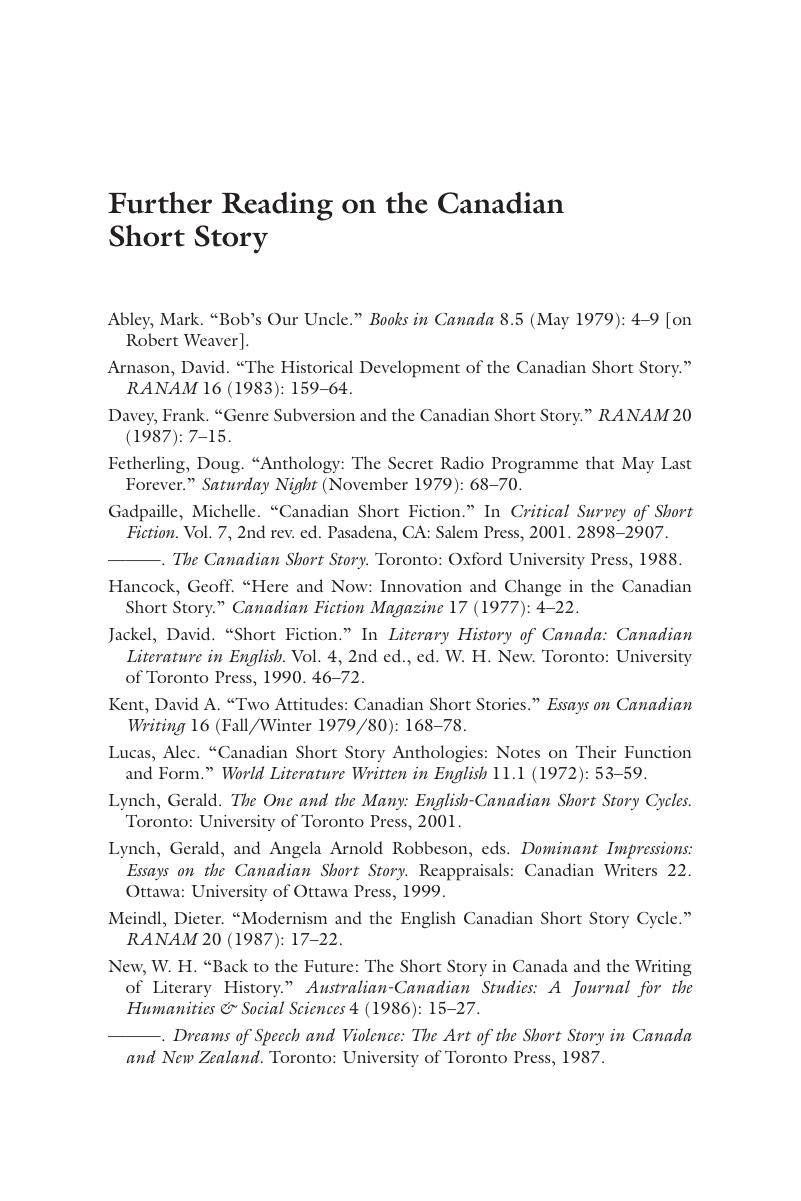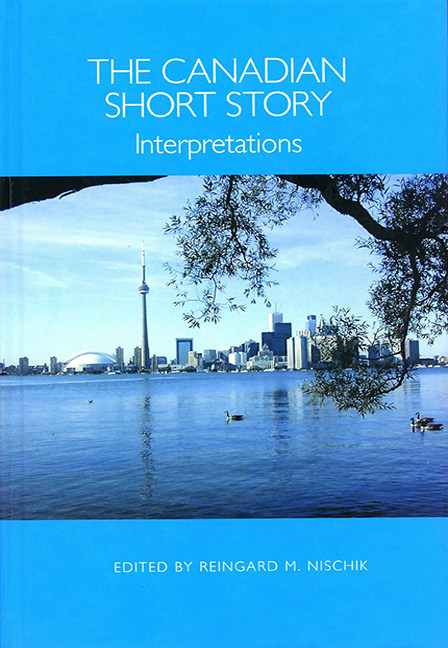Book contents
- Frontmatter
- Contents
- Preface
- The Canadian Short Story: Status, Criticism, Historical Survey
- 1 Canadian Animal Stories: Charles G. D. Roberts, “Do Seek Their Meat from God” (1892)
- 2 Tory Humanism, Ironic Humor, and Satire: Stephen Leacock, “The Marine Excursion of the Knights of Pythias” (1912)
- 3 The Beginnings of Canadian Modernism: Raymond Knister, “The First Day of Spring” (written 1924/25)
- 4 From Old World Aestheticist Immoralist to Prairie Moral Realist: Frederick Philip Grove, “Snow” (1926/1932)
- 5 Psychological Realism, Immigration, and City Fiction: Morley Callaghan, “Last Spring They Came Over” (1927)
- 6 Modernism, Prairie Fiction, and Gender: Sinclair Ross, “The Lamp at Noon” (1938)
- 7 “An Artful Artlessness”: Ethel Wilson, “We Have to Sit Opposite“ (1945)
- 8 Social Realism and Compassion for the Underdog: Hugh Garner, “One-Two-Three Little Indians” (1950)
- 9 The Perils of Human Relationships: Joyce Marshall, “The Old Woman” (1952)
- 10 The Social Critic at Work: Mordecai Richler, “Benny, the War in Europe, and Myerson's Daughter Bella” (1956)
- Myth and the Postmodernist Turn in Canadian Short Fiction: Sheila Watson, “Antigone” (1959)
- 12 The Modernist Aesthetic: Hugh Hood, “Flying a Red Kite” (1962)
- Doing Well in the International Thing?: Mavis Gallant, “The Ice Wagon Going Down the Street” (1963)
- 14 (Un-)Doing Gender: Alice Munro, “Boys and Girls” (1964)
- 15 Collective Memory and Personal Identity in the Prairie Town of Manawaka: Margaret Laurence, “The Loons” (1966)
- 16 “Out of Place”: Clark Blaise, “A Class of New Canadians” (1970)
- 17 Realism and Parodic Postmodernism: Audrey Thomas, “Aquarius” (1971)
- 18 “The Problem Is to Make the Story”: Rudy Wiebe, “Where Is the Voice Coming from?” (1971)
- 19 The Canadian Writer as Expatriate: Norman Levine, “We All Begin in a Little Magazine” (1972)
- 20 Canadian Artist Stories: John Metcalf, “The Strange Aberration of Mr. Ken Smythe” (1973)
- 21 “A Literature of a Whole World and of a Real World”: Jane Rule, “Lilian” (1977)
- 22 Failure as Liberation: Jack Hodgins, “The Concert Stages of Europe” (1978)
- 23 Figures in a Landscape: William Dempsey Valgardson, “A Matter of Balance” (1982)
- 24 “The Translation of the World into Words” and the Female Tradition: Margaret Atwood, “Significant Moments in the Life of My Mother” (1983)
- 25 “Southern Preacher”: Leon Rooke, “The Woman Who Talked to Horses” (1984)
- 26 Nativeness as Third Space: Thomas King, “Borders” (1991)
- 27 Digressing to Inner Worlds: Carol Shields, “Our Men and Women” (1999)
- 28 A Sentimental Journey: Janice Kulyk Keefer, “Dreams:Storms:Dogs” (1999)
- Further Reading on the Canadian Short Story
- Time Chart: The Short Story in the USA, Canada, and Great Britain
- Notes on the Contributors
- Index
Further Reading on the Canadian Short Story
Published online by Cambridge University Press: 28 April 2017
- Frontmatter
- Contents
- Preface
- The Canadian Short Story: Status, Criticism, Historical Survey
- 1 Canadian Animal Stories: Charles G. D. Roberts, “Do Seek Their Meat from God” (1892)
- 2 Tory Humanism, Ironic Humor, and Satire: Stephen Leacock, “The Marine Excursion of the Knights of Pythias” (1912)
- 3 The Beginnings of Canadian Modernism: Raymond Knister, “The First Day of Spring” (written 1924/25)
- 4 From Old World Aestheticist Immoralist to Prairie Moral Realist: Frederick Philip Grove, “Snow” (1926/1932)
- 5 Psychological Realism, Immigration, and City Fiction: Morley Callaghan, “Last Spring They Came Over” (1927)
- 6 Modernism, Prairie Fiction, and Gender: Sinclair Ross, “The Lamp at Noon” (1938)
- 7 “An Artful Artlessness”: Ethel Wilson, “We Have to Sit Opposite“ (1945)
- 8 Social Realism and Compassion for the Underdog: Hugh Garner, “One-Two-Three Little Indians” (1950)
- 9 The Perils of Human Relationships: Joyce Marshall, “The Old Woman” (1952)
- 10 The Social Critic at Work: Mordecai Richler, “Benny, the War in Europe, and Myerson's Daughter Bella” (1956)
- Myth and the Postmodernist Turn in Canadian Short Fiction: Sheila Watson, “Antigone” (1959)
- 12 The Modernist Aesthetic: Hugh Hood, “Flying a Red Kite” (1962)
- Doing Well in the International Thing?: Mavis Gallant, “The Ice Wagon Going Down the Street” (1963)
- 14 (Un-)Doing Gender: Alice Munro, “Boys and Girls” (1964)
- 15 Collective Memory and Personal Identity in the Prairie Town of Manawaka: Margaret Laurence, “The Loons” (1966)
- 16 “Out of Place”: Clark Blaise, “A Class of New Canadians” (1970)
- 17 Realism and Parodic Postmodernism: Audrey Thomas, “Aquarius” (1971)
- 18 “The Problem Is to Make the Story”: Rudy Wiebe, “Where Is the Voice Coming from?” (1971)
- 19 The Canadian Writer as Expatriate: Norman Levine, “We All Begin in a Little Magazine” (1972)
- 20 Canadian Artist Stories: John Metcalf, “The Strange Aberration of Mr. Ken Smythe” (1973)
- 21 “A Literature of a Whole World and of a Real World”: Jane Rule, “Lilian” (1977)
- 22 Failure as Liberation: Jack Hodgins, “The Concert Stages of Europe” (1978)
- 23 Figures in a Landscape: William Dempsey Valgardson, “A Matter of Balance” (1982)
- 24 “The Translation of the World into Words” and the Female Tradition: Margaret Atwood, “Significant Moments in the Life of My Mother” (1983)
- 25 “Southern Preacher”: Leon Rooke, “The Woman Who Talked to Horses” (1984)
- 26 Nativeness as Third Space: Thomas King, “Borders” (1991)
- 27 Digressing to Inner Worlds: Carol Shields, “Our Men and Women” (1999)
- 28 A Sentimental Journey: Janice Kulyk Keefer, “Dreams:Storms:Dogs” (1999)
- Further Reading on the Canadian Short Story
- Time Chart: The Short Story in the USA, Canada, and Great Britain
- Notes on the Contributors
- Index
Summary

- Type
- Chapter
- Information
- The Canadian Short StoryInterpretations, pp. 387 - 388Publisher: Boydell & BrewerPrint publication year: 2007

